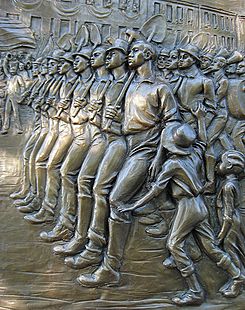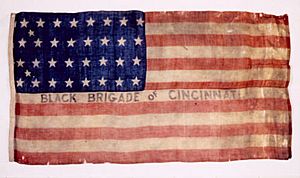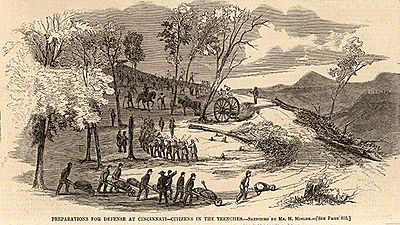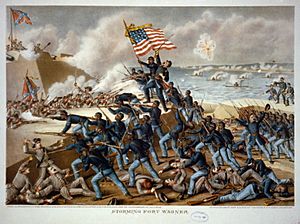Black Brigade of Cincinnati facts for kids
Quick facts for kids Black Brigade of Cincinnati |
|
|---|---|

The Black Brigade of Cincinnati American Civil War Memorial honors the free African Americans who constructed the defensive fortifications, around Cincinnati, Ohio, during the American Civil War, in preparation of a potential Confederate attack. The Brigade would later shoulder their shovels in a military manner and march in the victory parade through the city.
|
|
| Active | September 2, 1862 - September 20, 1862 |
| Allegiance | United States of America |
| Branch | Cincinnati volunteer militia Union Army |
| Size | Battalion-brigade (700) |
| Nickname(s) | Black Brigade |
| Engagements | No combat experience |
| Commanders | |
| Notable commanders |
|
The Black Brigade of Cincinnati was a group of African-American men who helped defend the city of Cincinnati, Ohio during the American Civil War in 1862. Cincinnati was in danger of being attacked by the Confederate Army. These men were among the first African Americans to work in the military defense for the Union (the North).
They built strong defenses like forts, military roads, and trenches. These defenses stopped the main threat to Cincinnati during the Civil War. Even though they faced unfair treatment, their hard work protected the city.
Contents
How the Black Brigade Helped Defend Cincinnati
Life for African Americans in Cincinnati Before the War
Before the Civil War, life for black people in Cincinnati was very difficult. Even though some people in the city wanted to end slavery, many others were not friendly towards African Americans. They were worried about money and business with the South.
Laws in Ohio, called the Black Laws, made it hard for black people to live there. They had to prove they were free and pay a large sum of money to guarantee good behavior. Black people could not vote or speak against white people in court.
Offering to Help the Union Cause
In August 1862, the Confederate Army was getting closer to Cincinnati. Black citizens of Cincinnati met to offer their help to defend the city. They wanted to join the fight for the Union.
However, their offer was turned down. City officials told them there was no need for their help in a "white man's war." This was against the wishes of Maj. Gen. Lew Wallace, a Union commander. He wanted to use the city's black residents to build defenses.
Confederate Troops Get Closer
On August 30, Confederate troops won a battle in Kentucky, about 100 miles south of Cincinnati. By early September 1862, Union soldiers from Ohio and other states were sent to Cincinnati to protect it.
General Wallace took control of the city on September 1. The mayor asked all men to help defend Cincinnati.
Black Men Forced to Work
On September 2, 1862, the Cincinnati police began forcing black men to build defenses. They were treated roughly and not told what was happening. Many feared they might be taken to Kentucky and enslaved.
One person wrote that the police treated the men badly. They were arrested and put in a pen. Some were forced to work at the river, while others were made to be servants or cooks for Union troops. About 400 men were held for two days. They worked for 36 hours straight without sleep and received little food. Only one local newspaper spoke out against this unfair treatment.
Organizing the Black Brigade

When General Wallace heard about the mistreatment, he put Colonel William M. Dickson in charge. Dickson let the seized men go home. He then asked for black volunteers to report for duty the next day. The police were no longer allowed to arrest black men unless they committed a crime.
On September 5, at 5 a.m., 706 black volunteers showed up for duty. Colonel Dickson became their commander. The Black Brigade received its own military flag. They were paid $13 a month, the same as a Union Army private. They also had the right to visit their families.

The Black Brigade was sent into Northern Kentucky, ahead of the Union lines. They did not have weapons. They built a bridge to get there. Their work included digging trenches, clearing trees, and building forts, storage areas for ammunition, and roads. They often worked very close to where Confederate forces might be.
Confederate General Henry Heth arrived with 8,000 soldiers by September 11. After two days, they left. They believed they could not win against the large volunteer force defending Cincinnati.
The Black Brigade continued working until September 20, when the threat to Cincinnati was over. They had cleared hundreds of acres of forests and dug miles of trenches. They built forts and roads along the border with Northern Kentucky. These defenses were far enough from Cincinnati to protect the city from attack.
In total, 1,000 black men helped defend the city. About 700 built the defenses, and 300 worked in military camps or on gunboats. Sadly, one man, Joseph Johns, died when a tree fell on him.
Colonel Dickson thanked the brigade members for their hard work. He told them they had done their duty and earned the respect of everyone. The defenses built by the Black Brigade are seen as key to stopping the Confederate threat to Cincinnati in 1862.

Because of racial segregation, black men were not allowed to join the all-white volunteer groups. The Black Brigade was not meant to be armed soldiers, so they did not fight in battles. However, some of these men later joined other Union Army regiments, like the 54th Massachusetts Infantry Regiment or the United States Colored Troops.
Legacy and Recognition
The Black Brigade of Cincinnati was the first group of African Americans used for military purposes by the North during the American Civil War.
In 2012, the U.S. Senate passed a resolution. This resolution officially recognized the members of the Cincinnati Black Brigade as veterans.
Memorial Monument

A special monument to the Black Brigade was built in Smale Riverfront Park in Cincinnati. It was dedicated on September 9, 2012, which was 150 years after the defense of Cincinnati.
The monument was designed by John Hebenstreit and Carolyn Manto. It has three life-size bronze figures and panels that list the names of all 700 soldiers in the Black Brigade.
Notable Soldiers
- Captain Peter Fossett
- Powhatan Beaty

